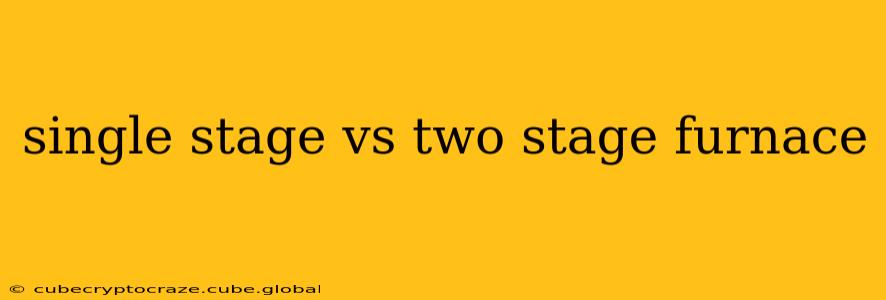Choosing the right furnace is crucial for maintaining a comfortable and energy-efficient home. Two significant contenders in the heating market are single-stage and two-stage furnaces. Understanding their differences is key to making an informed decision. This comprehensive guide will delve into the nuances of each system, helping you determine which best suits your needs and budget.
What is a Single-Stage Furnace?
A single-stage furnace operates at one speed: full blast. When the thermostat calls for heat, the furnace blower and burner ignite at maximum capacity until the desired temperature is reached. Then, it shuts off completely. This on-off cycle can lead to temperature fluctuations, making your home feel less consistently comfortable.
What is a Two-Stage Furnace?
Unlike its single-stage counterpart, a two-stage furnace offers more nuanced temperature control. It operates at two distinct levels: a low-speed "energy-saving" mode and a high-speed "heating" mode. The furnace typically starts in low-speed mode, maintaining a steady, comfortable temperature with less dramatic temperature swings. When the temperature dips, it automatically switches to high-speed mode to quickly raise the temperature. This allows for more precise temperature regulation and potentially increased energy efficiency.
Single Stage vs. Two Stage Furnace: Key Differences
Here's a table summarizing the key distinctions between single-stage and two-stage furnaces:
| Feature | Single-Stage Furnace | Two-Stage Furnace |
|---|---|---|
| Operation | On/Off, full capacity | Two levels: low and high capacity |
| Temperature Control | Less precise, larger temperature swings | More precise, smaller temperature swings |
| Energy Efficiency | Generally less efficient | Generally more efficient |
| Comfort Level | Can lead to temperature fluctuations | More consistent, comfortable temperature |
| Cost | Typically less expensive upfront | Typically more expensive upfront |
| Lifespan | Comparable lifespan to two-stage units | Comparable lifespan to single-stage units |
How Much More Efficient is a Two-Stage Furnace?
Two-stage furnaces generally offer increased energy efficiency compared to single-stage models. The ability to maintain a consistent temperature using low-speed operation reduces the frequency and duration of high-speed heating cycles, resulting in lower energy consumption. The exact efficiency improvement varies depending on factors like home size, insulation, and climate. However, a well-maintained two-stage furnace can significantly reduce your heating bills over time.
Is a Two-Stage Furnace Worth the Extra Cost?
The upfront cost of a two-stage furnace is typically higher than a single-stage model. However, the long-term savings in energy costs, combined with the increased comfort level, often make it a worthwhile investment. The return on investment (ROI) depends on individual circumstances, but many homeowners find the increased efficiency and comfort justify the added initial expense.
Which Furnace is Better for Allergies?
Both single-stage and two-stage furnaces can be equipped with air filtration systems. However, a two-stage furnace’s more consistent operation and the lower speed's gentler airflow can contribute to better air circulation and potentially reduce the distribution of allergens throughout the home. This makes the two-stage unit potentially a more comfortable option for allergy sufferers. Consider adding a high-efficiency air filter regardless of furnace type for optimal air quality.
How Long Do Two-Stage Furnaces Last?
The lifespan of a two-stage furnace is comparable to a single-stage furnace, typically lasting 15-20 years with proper maintenance. Regular maintenance, including annual inspections and filter changes, is crucial for extending the lifespan of any furnace, regardless of its type.
What Size Furnace Do I Need?
Determining the appropriate furnace size is critical for optimal performance and efficiency. A furnace that's too small will struggle to heat your home adequately, while one that's too large will cycle on and off frequently, wasting energy and reducing comfort. Consult with a qualified HVAC professional to calculate the proper BTU (British Thermal Unit) rating for your home's heating needs. This calculation considers factors such as the square footage of your home, insulation levels, climate, and the number of windows and exterior doors.
In conclusion, the choice between a single-stage and a two-stage furnace depends on your individual needs and priorities. If budget is your primary concern, a single-stage furnace may suffice. However, for enhanced comfort, improved energy efficiency, and potentially better air quality, a two-stage furnace is generally the better investment in the long run. Consulting a qualified HVAC professional is always recommended to determine the best option for your specific home and circumstances.
